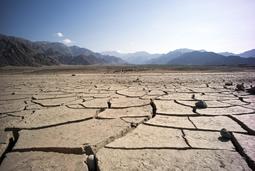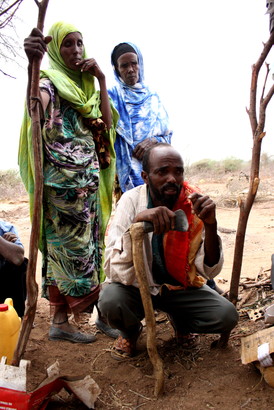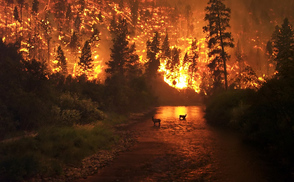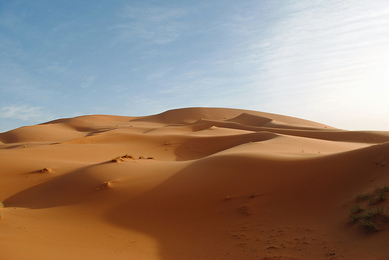 India no water, no life India no water, no life More than 300 people have died in India due to heat related health problems. The State of Bihar has forbidden cooking fires between 9 am and 6 pm. The scorching temperatures are expected to last through May. Daytime temperatures hover in the mid-forties Celsius (113 F.) Many of the deaths occur among the poor who may not have adequate water close by and lack electrical connections. Air conditioning is scarce among the shanty towns. Fans don’t cool at temperatures in the forties and serve to further dehydrate people. Windy conditions have made the situation. The winds are blowing from the west across the hot interior sucking more moisture out of the air. Some areas have had deliveries of water, but many areas have received little aid. Farmers have been particularly hard hit. The monsoon rains in 2015 which provide most of the year’s water, soaking into the soil and replenishing wells were scanty. And the drought continues.Thousands of farmers are reported to have committed suicide. Laws in India prevent the seizure of farms due to debts if the farmer dies. At last count, more than 300 million people are suffering from drought in India. The phenomenon known as El Nino is being blamed for the hot, dry conditions. The warmer than usual Pacific Ocean affects weather around the globe. Parts of Canada had no real winter while central and eastern Canada suffered with cold. Africa has been hit with drought conditions, especially in countries along the eastern edge of the continent. Estimates of up to 36 million people in Africa may need food aid due to drought and failed crops. South Africa has reported that 2015 was the driest year since written records were started in 1904. The Horn of Africa including Ethiopia, Kenya, Somalia, Uganda and Djibouti is parched. The UN has warned that money must be found to feed tens of millions of people to prevent a catastrophe. As our planet’s temperature rises, more disruptions to weather patterns can be expected. More extreme weather events are predicted to be the “new norm” displacing millions and causing widespread misery. Sources: ABC News The weather Channel Al Jazeera
1 Comment
 No water, no life No water, no life Ethiopia has been hit with a devastating drought that has killed crops and livestock and dried up wells. This is the worst drought the farmers have faced since the 1980s when the combination of drought and fighting killed a million people. Currently there are about 8.5 million people who are in need of emergency food supplies. The number is expected to swell to around 15 million by next year. The UN is urging donor nations to give generously to avert a repeat of that tragedy. In spite of great need in many areas, they have received about $200 million. Estimates of need hover in the one billion dollar range. The Ethiopian government is coping as best it can, but food reserves are meager. They are expected to be exhausted by year end. The weather phenomenon known as El Nino(the Christ Child) because of its appearance close to the Christmas season is particularly strong this year. The past summer was very warm and has heated the Pacific Ocean to record temperatures. The vast ocean in turn influences weather around the world. Some areas will receive record breaking downpours and others no rain at all. The north of Africa is experiencing drought. Somalia is coping with flooding which has displaced upwards of 90 000 people. The whole of the east coast of Africa is experiencing the effect of this year’s El Nino. Zimbabwe, Malawi and South Africa are coping with drought. Zimbabwe is expected to have 1.5 million people in immediate need of food aid. Climate scientists have predicted that as the planet warms, old weather patterns will become disrupted. Some areas will receive more rain, others less. Some areas will experience warmer winters, others colder. But the trend is a higher global average. The polar regions have been showing some of the greatest increases in average temperature. Canada is experiencing current winter temperatures of 3 to 4 degrees Celsius this winter season. Sources: Al Jazeera All Africa NOAA Some turned their livestock out to fend for themselves rather than leave them trapped by fences or in barns.
One woman who was forced to flee the firestorm described it to a local newspaper. "It was like a tornado coming — a fire tornado coming up the valley," she said, recalling the moments before their hasty departure. "There was no time. You just have to run."Kelowna Daily Courier While the Rock Creek Fire continues to dominate local news, many other smaller wildfires have consumed people’s homes in other areas of the parched province. Three days ago firefighters were forced to call off the helicopters and aircraft fighting one such fire when someone foolishly chose to fly a drone over the fire, making it unsafe for the aircraft. This was the second incident of this kind this year. BC has registered 1600 wildfires so far this year. Fire season usually starts mid-way through July but because of the drought, it began in May. South of the border, the western US states have been coping with drought and massive wildfires as well. Also at NEWTEKWORLDNEWS: Heat and drought threaten BC salmon runs Western Canada scorched by wildfires Sources: Kelowna Daily Courier
There are several factors that are increasing the pressure and drawdown of these fossil reserves. Climate change which is expected to change rainfall patterns and increase evaporation will increase pressure to source groundwater. Already the drought in California is forcing more dependence on groundwater with the result that the levels are dropping quite rapidly. Some of the drawdowns in other areas have been quite spectacular. The High Plains Aquifer in Texas has dropped 50m since being accessed in the 1940s. The Nubian aquifer in N. Africa has dropped 60m since records were kept.
Not only climate change affects our exploitation of groundwater. Agricultural practises, industries, mining including fracking all take their toll. The exponential increase in the human population this last century has put pressure on supplies. There are stopgap measures to combat a temporary drought, but history is full of accounts of civilizations that have disappeared along with their water sources. Currently it is some of the world’s poorest people who depend most heavily on ground water and are drawing down their resources most rapidly. The Arabian Aquifer which serves 60 million people is listed as the most stressed, followed by the Indus Basin in northern India and Pakistan and the Murzuk-Djado Basin in Libya and Niger. People cannot survive without adequate water. Related reading at NEWTEK: California faces emergency drought regulations Taiwan coping with severe drought History making mandatory water restrictions California Drought on Vancouver Island ups fire risk Sources: RT Online Library
But it is likely that the amount of carbon dioxide in the atmosphere will continue to heat our world with major changes to weather. Some places are predicted to get wetter and some drier. More extreme weather events, including protracted droughts, are predicted.
The provincial government is expressing concern about the changing picture. British Columbia’s coastal communities already face flood risks related to precipitation and river flows, and climate change will add new risks from sea-level rise and storm surges. British Columbia, Environment On a personal level, our hay crop was cut and harvested a good three weeks earlier than it has ever been. The yield is down by a third. You may understand my annoyance with the TV weather person going on about another nice day and more good days to follow. Good for farmers means some useful rain and soon. Sources: Rethinking Water government publication CTV News The Tyee British Columbia Environment |
Barbara McPherson
Blogger, gardener, farmer. Working toward food security and a 30 foot
diet. Addicted to reading. Love this planet, especially my little corner
on Vancouver Island, Canada Archives
October 2016
Categories
All
|




